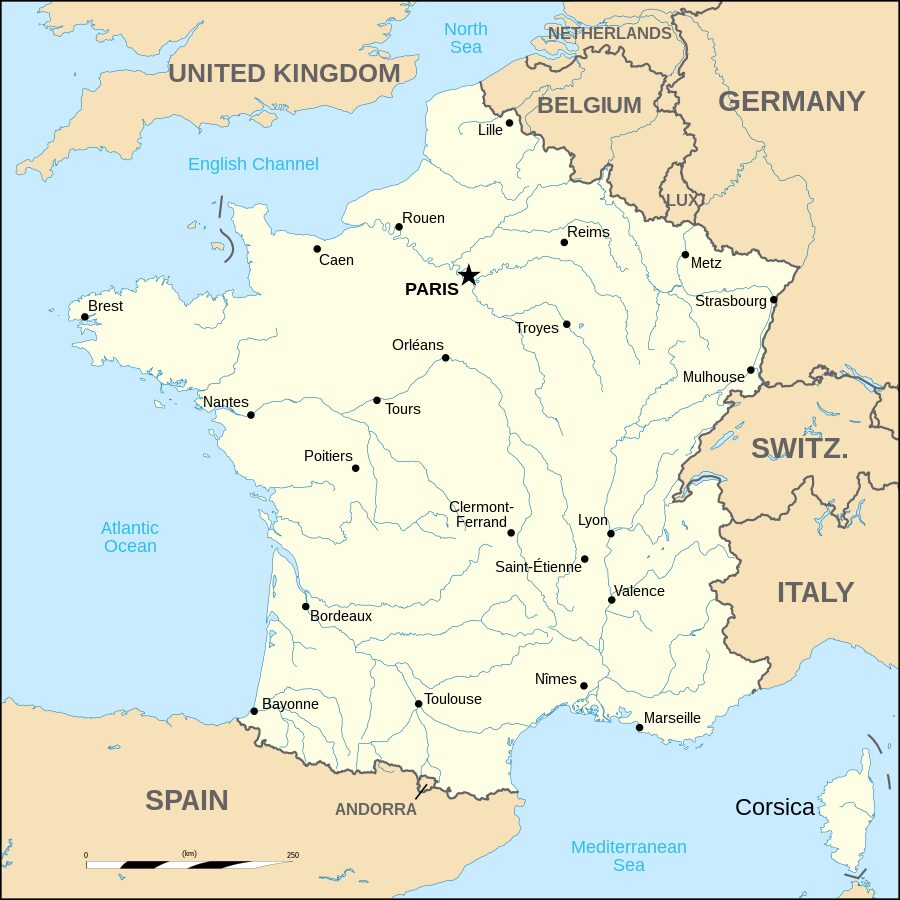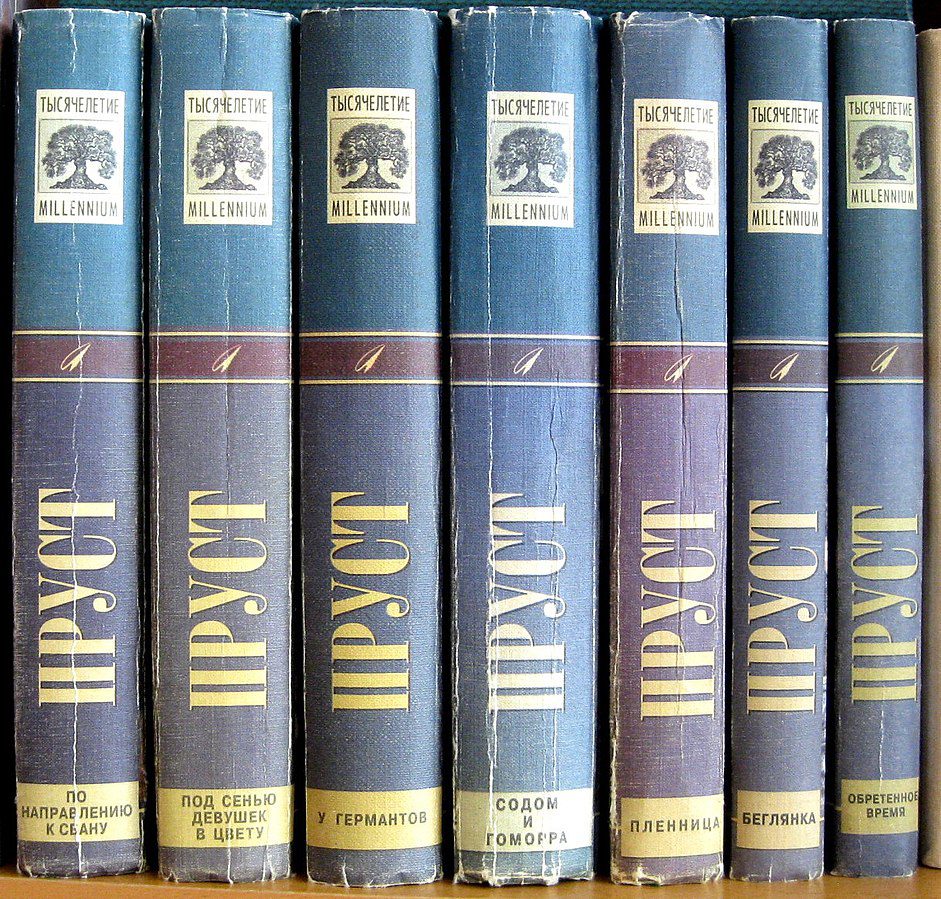France. Photo by Rosss. Wikimedia Commons
35 Best Facts About France
Located in northwest Europe, France, or the French Republic, is a sovereign state.
France, one of the most influential countries in Western cultural history, has played a key role in world events and has had former colonies all over the world.
France has historically served as a geographical, economic, and linguistic link between northern and southern Europe, being bordered by the Atlantic Ocean, the Mediterranean Sea, the Alps, and the Pyrenees.
It is one of the premier industrial powers in the world and the largest agricultural producer in Europe.
France is one of the oldest countries in the world. It was created in the Middle Ages when several duchies and principalities joined forces under a single king.
Even if the country’s regions have recently been given some degree of autonomy, central authority remains with the state now as it did before.
The French people view the state as the principal guarantor of their freedom, and in return, the state offers a wide range of benefits to its people, including free healthcare, pensions, and pension plans.
The 35 best facts about France are outlined below.
1. The Largest EU Member State is France
The largest nation in the EU, with a total area of 543,940 km2, is France.
It is eight times bigger than Ireland and twice as big as the United Kingdom.
France is the third-largest country in Europe after Ukraine and Russia.
2. France Is One of the Top Tourist Destinations in The World

United Kingdom In Europe. Photo by TUBSEmail Silk.svg Gallery. Wikimedia Commons
One of the top 10 tourist destinations globally is France.
For the past 30 years, the country has drawn tourists because of its stunning architecture, rich cultural heritage, and mouthwatering cuisine.
The country welcomed almost 90 million visitors from other countries in 2019.
Additionally, behind Bangkok and London, Paris, the capital of France, is the third-most visited city in the world.
3. All French Catholic Churches Display a Rooster

Pope Nicholas 1. Photo by Artaud de Montor (1772–1849). Wikimedia Commons
The Gallic Rooster is both a Christian and a patriotic French symbol.
The rooster is used for religious purposes by many different cultures, not just France and Christianity.
The Egyptians, Chinese, Japanese, Indians, Greeks, and even Thai people have used it.
Because the rooster’s crow heralds or announces daybreak and indicates the passage from night to day, the rooster has long been associated with the sun in mythology.
Roosters are viewed as being courageous, brave, and strong.
Pope Nicholas ordered in the ninth century that all churches place roosters on their steeples or domes as a symbol and physical reminder of Peter’s betrayal of Christ prior to his crucifixion.
And so roosters began to daybreak church steeples and weathervanes. All catholic churches in France therefore display a rooster. To read about churches in France click this link
4. France’s Nickname is “Hexagon”

Metropolitan France. Photo by Delphi234. Wikimedia Commons
The moniker “Hexagon” is occasionally used to refer to Mainland France.
It’s because of the way it looks on a map of the area.
It resembles a hexagon quite a bit because it has six sides. One of the less well-known truths about France is that.
5. A Lot of Inventions Come from France
A lot of the items we use today are thanks to French scientists and inventors.
Louis Braille developed the Braille System, a writing and reading system for the blind.
While Alexandre- Ferdinand Godefroy is credited with inventing the first hairdryer, Rene Laennec is credited with inventing the stethoscope.
The earliest hot air balloon flights, meanwhile, are credited to the Montgolfier brothers.
6. France Shares a Border with A Sizable Number of Neighbors
France’s hexagonal form makes for a sizable number of neighbors.
France shares boundaries with Belgium, Luxembourg, Germany, Switzerland, Monaco, Italy, and Andorra in continental Europe.
In addition, France shares international boundaries with the Netherlands, Suriname, and Brazil in the Americas.
7. One of France’s Kings Had the Shortest Reign in History

Charles X of France. Photo by Henry Bone. Wikimedia Commons
The fact that one of its monarchs had the shortest reign is one of the most intriguing things to know about France.
Following the abdication of his father Charles X in July 1830, King Louis XIX reigned for only 20 minutes. Later, Louis XIX did the same in order to give his nephew the throne.
Prince Luis Filipe, who succeeded Louis XIX as the King of Portugal following the attack that killed his father, shares this distinction with Louis XIX.
However, Lus Filipe was also hurt during the same assault and passed away 20 minutes after being crowned King.
8. It’s Possible That France’s National Anthem is Among The Bloodiest
Claude Joseph Rouget composed a war song with graphic wartime lyrics in 1792, following the end of the French Revolution and France’s declaration of war against Austria.
Chant de guerre pour l’Armée du Rhin, or “War Song for the Army of the Rhine,” was the song’s official title.
Later, it underwent a name change to become the Marseillaise, which is now France’s national anthem.
Since it was adopted as the national anthem, the song has caused controversy and was both banned and reinstated numerous times between 1804 and 1945.
Ever since, it has consistently served as the national anthem of France.
9. The Annual Consumption of Snails by The French Population Is Over 30,000 Tons

Escargots. Photo by Marianne Casamance. Wikimedia Commons
Unbelievably, the French consume up to 30,000 tons of snails each year. Every year, a single resident eats more than 500 snails. Snails are commonly referred to as “escargot” in France.
People typically consume them during holidays and vacations because they are regarded as a delicacy in France.
They are most frequently consumed as appetizers when fried with butter and garlic.
10. It Wasn’t Until 1539 That France Made French Its Official Language
The majority of people think that France has always spoken French as its official language.
In reality, it wasn’t until 1539 that French was adopted as the nation’s official language for the administration of justice and the law.
In the past, official documents were written in medieval Latin, which was the language of the Roman Catholic church.
And different regions of France spoke various regional dialects.
11. The French Army Was the First to Use Camouflage
The French Army was the first to use camouflage in 1915, which is another interesting fact about France.
The phrase “to make up for the stage” is where the word “camouflage” originated in French.
Artists known as camo fleurs were employed during World War I to paint all the machinery and vehicles to match their particular environments.
12. A Mayor in Six French Towns is The Only Person Still Alive

Verdun. Photo by M.Minderhoud. Wikimedia Commons
Six villages in France, close to Verdun, have a mayor who oversees a population of zero.
The mayor is in charge of keeping these villages because they were devastated during World War I in order to honor those who gave their lives fighting for France.
13. Mountain Blanc, The Second-highest Mountain In Europe, Is Located In France

Mont Blanc Massiv. Photo by Woudloper. Wikimedia Commons
Mountain Blanc, the highest peak in all of Europe, is located in France.
It is astoundingly high at 4,808 meters above sea level and is situated in the French Alps.
It takes around 10 to 12 arduous hours of climbing to reach the summit; therefore, it is not easy.
But if you’re unable to accomplish that, don’t worry; at Aiguille du Midi, you can still take in the scenery by using Europe’s tallest picturesque cable car.
14. France Is Known for Production of Cheese

Roquefort Cheese. Photo by Thesupermat. Wikimedia Commons
It wouldn’t be inaccurate to claim that cheese is so important to the French that they cannot even envisage their lives without it.
France is renowned for both its production and consumption of cheese. Up to 1600 different varieties of delectable cheese are produced by it.
Roquefort, Reblochon, Brie de Meaux, and camembert are a few of the most well-known cheeses.
Therefore, whenever you visit France, make sure to sample these various cheeses.
Statistics show that France produces between 1.7 and 1.8 million tons of cheese from cow’s milk each year. To read more about French cheese click here
15. There Is a Renowned French Village With Only “One” Resident
Rochefourchat, a small commune in the Drôme department of the Auvergne-Rhône-Alpes region in southeast France, is famous for having the least populous village in all of France.
It feels like traveling back in time to take a quick stroll through this tiny community, which has a total area of 12.74 km2 (4.92 sq mi).
There is an outdated phone, an old church, and an old castle’s ruins. The only resident of Rochefourchat, who is presumed to be a member of the Jossaud family, is listed as being the only resident.
A little stone castle called “Rocha Forcha,” allegedly built in 1178 by the bishop in charge of the neighborhood as a defense against the Holy Roman Emperors, was the subject of some contradicting facts concerning this tiny community.
Lord Rey de Noinville eventually acquired the castle and held it until his passing in 1766.
A French trader called Pierre Jossaud purchased the area surrounding the castle and changed its name to Rouchefourchat thirty years later, in 1796. Since then, it has been passed down via the Jossaud family.
16. Over 11000 Chateaux Are Thought To Exist In France
People typically envision a large fortified castle with reinforced walls and sometimes even a moat when they think of a chateau.
However, the French word for “chateau” refers to much more than just a castle.
It is difficult to determine the precise number of castles in France in the traditional sense because a chateau can be anything from a massive medieval fortification to a magnificent country house that adorns several wine farms.
It is thought that in France there are over 11000 chateaus to date. To read more about castles in France click this link
17. Food Wastage Is Not Permitted in France
In February 2016, France passed a law to end food waste and fight hunger.
This regulation mandates that all grocery stores donate their unsold and excess food to charities and food banks rather than throwing it away.
18. For Over 300 Years, French Was the Official Language of England

King William I (The Conqueror). Photo by Unknown author. Wikimedia Commons
It’s difficult to believe that from 1066 until 1362, French was England’s official language.
However, Anglo-Norman French was brought to the country in 1066, following William the Conqueror’s leadership of the Norman invasion and subsequent occupation of England.
Some of the people who knew this language fluently were high-ranking officials, aristocrats, and members of the royal family.
English became the official language of the government in 1362, however, after the Pleading in English Act was enacted by parliament.
This was due to the fact that judicial proceedings were conducted in Norman French, which was mostly unknown to the English populace, who were therefore unaware of what was being spoken.
19. France is The Country That Produces The Priciest Wine in The World

Burgundy bottles. Photo by Limegreen at English Wikipedia. Wikimedia Commons
Aside from its food, France is known for producing the most expensive bottle of wine in the world.
At an auction, a 750 cc bottle of Burgundy fetched the top offer of $558,00. Some of the most well French wine areas include Burgundy, Champagne, Bordeaux, and Rhode Valley.
The French consume tons, or around 25 million gallons, of wine annually in addition to making the most elegant wine.
France is the second-largest consumer of wine in the world. To read more on French wine click this link
20. The National Motto Is “Liberté, Égalitié, Fraternité” or “Liberty, Equality, Brotherhood”

Napoleon Bonaparte. Photo by Andrea Appiani. Wikimedia Commons
The well-known adage first appeared during the Revolution of 1789–1799 and was included in the 1946 and 1958 constitutions.
Today, you may still find it alongside “Marianne,” a symbol of the Republic’s victory, on coins, postage stamps, and government logos.
The concepts laid out in Napoleon Bonaparte’s Code Civil following the revolution, in the 1800s, still serve as the foundation for the majority of French law today.
To read about other interesting facts about Napoleon Bonaparte click here
21. The First Artificial Heart And Face Transplants Were Performed By French Specialists

Georges Pompidou Hospital. Photo by Oliver H. Wikimedia Commons
At the Georges Pompidou Hospital in Paris, the first artificial heart transplant ever took place in December 2013.
The lithium-ion battery-powered artificial organ was three times heavier than the real one.
The world’s first face transplant was also performed by a French surgeon.
22. You Can Wed A Deceased Person in France!

Champs Elysees from the Arc. Photo by ASaber91. Wikimedia Commons
You can get married posthumously under French law in certain circumstances, which is a fairly disturbing fact about France.
You must demonstrate that the deceased intended to wed you while they were still alive in order for this to be allowed. The French president must also give his consent.
The most recent case to be approved took place in 2017, when the partner of a gay policeman who had been shot dead on Paris’ Champs-Elysees by a jihadist was given permission to wed his partner after his death.
23. In 1895, the French Filmmaker Lumière Presented The First Motion Picture To A Large Audience

Auguste Lumiere. Photo by Henri Lumière. Wikimedia Commons
The short films that the Lumière brothers, Auguste Marie Louis Nicolas and Louis Jean, created between 1895 and 1905 as well as their Cinématographe motion picture technique made them famous.
On December 28, 1895, at the Grand Café in Paris, the illustrious couple presented the first public cinema screening in history.
La sortie des ouvriers de l’usine Lumière (Workers Leaving the Lumière Factory) was their first film as directors.
The audience was greatly taken aback by the five-second black-and-white film, which simply showed workers leaving the Lumière facility.
According to legend, Louis Lumière declared that cinema is “an invention without a future” in 1895. Oh, how little he understood.
24. French Fries & French Toast Were Not Created in France
It’s not true that French toast and fries originated in France just because they have a French name.
Joseph French, a native of New York, is credited with creating French toast.
Conversely, French Fries were first consumed in the region of Belgium where French is spoken.
25. Jeanne Louise Calment, A Frenchwoman, Was The Oldest Person To Ever Live
The longest human life span that has been completely verified is 122 years and 164 days.
Jeanne Louise Calment passed away on August 4, 1997, and she was born on February 21, 1875, in France.
She saw the creation of television, the modern automobile, and airplanes, as well as the unveiling of the Eiffel Tower in 1889, two World Wars, and other significant events.
The life expectancy in France in 2018 was 79.4 years for males and an interesting 85.3 years for women. The average life expectancy for men and women in France is 83 years old, ranking it 14th in the world.
26. In 2013, France Made Same-sex Unions Lawful
France became the ninth nation in Europe and the fourteenth nation overall to allow same-sex unions when President Françoise Holland signed the legislation into law on May 18, 2013.
Even though polls at the time indicated that roughly 50% of French people approved it, not everyone called “family values.”
27. France Is The Nation With The Most Nobel Prize Winners In Literature

Victor Hugo. Photo by Étienne Carjat. Wikimedia Commons
It is safe to assume that France has produced some of the most significant writers and intellectuals in the history of the globe, since 15 French people have won the prestigious award since 1901.
Sully Prudhomme, a French poet and essayist, was that year’s inaugural recipient of the honor.
René Descartes, Voltaire, Charles Baudelaire, Blaise Pascal, Sully Prudhomme, and Victor Hugo are a few of France’s most well-known poets, novelists, and writers.
28. The Croissant Was Not Invented in France

French King Louis XVI. Photo by Antoine-François Callet. Wikimedia Commons
Austrian croissants are the most well-known French pastries.
During her marriage to the French king Louis XVI, Austrian princess Marie Antoinette is claimed to have brought croissants to France.
29. The Most Frequented Museum In The World Is The Louvre In France

Louvre museum at night time. Photo by Benh LIEU SONG (Flickr). Wikimedia Commons
The renowned Louvre is the most visited museum in the world, with a staggering 9.6 million visitors in 2019.
The wonderful museum, housed in the center of Paris, contains about 38,000 pieces of ancient art and antiquities.
These include the Venus de Milo, the Mona Lisa, and the courtyard-located glass Louvre Pyramid designed by IM Pei.
Unsurprisingly, one of the most popular tourist destinations in Paris is the Louvre.
To rea more on museum click on this link and also to read further about Paris Museums click also this link
30. High-speed Trains Require Tickets For Live Snails To Board
It is illegal to transport live snails on a high-speed train in France without them having their own tickets, according to French law.
In reality, every tamed animal weighing less than 5 kilograms must travel for a fee.
When a ticket inspector saw a Frenchman carrying the animals on a TGV in 2008, he was actually fined.
Fortunately, the charge was ultimately waived by France’s publicly held rail firm, SNCF.
31. On Train Platforms, It Is Not Permitted For Couples To Kiss
In France, it is forbidden to kiss on a railway platform. The railway chief asked for the introduction of this law in 1910.
This law’s sole objective was to avoid delays in train departure.
32. Paris The Busiest Train Station In Europe Is Called Gare du Nord

Gare du Nord . Photo by Mbzt. Wikimedia Commons
The busiest train station in both Europe and the entire world is Gare du Nord in Paris. Every year, more than 214 million people use it.
Originally constructed in 1846, the station was too tiny to function, so it was dismantled and rebuilt in 1889. Between the 1930s and 1960s, more additions were made.
Additionally, the station will need to undergo additional construction work in order to get ready for the Paris 2024 Summer Olympic Games.
This will enable it to accommodate 200,000 more passengers each day.
33. The French Rail System Ranks Ninth In The World And Is The Second-largest In Europe

TGV.Photo by WindowCrash. Wikimedia Commons
The French railway network is the second largest in Europe and the ninth largest in the world, with a total length of 29,000 km.
One of the first nations in the world to use high-speed technologies was France.
The TGV high-speed rail was first offered in 1981 by the government-owned Société Nationale des Chemins de fer Français (SNCF).
The ordinary long-distance passenger services in France are referred to as Intercités, whereas the high-speed long-distance passenger services are referred to as Train à Grande Vitesse (TGV).
There are more than 1,550 kilometers in the country’s current high-speed network. The high-speed rail project between Tours and Bordeaux extends the network by 302 kilometres.
34. The Tour de France Is The Best Cycling Competition In The World
The largest bicycle race in the world, the Tour de France, is conducted in July each year in France.
Over a century has passed since this race first took place in 1903. More than 3200 kilometers are covered throughout the course of the 23-day race.
35. The Longest Novel Ever Written Is in French

“In search of Lost Time” Novel. Photo by Тавьев Максим. Wikimedia Commons
The world’s longest book, “In Search of Lost Time” (Remembrance of Things Past), was written by Marcel Proust, a well-known author from France.
The book has 3000 pages and 7 volumes. It is also a fantastic read.
Planning a trip to Paris ? Get ready !
These are Amazon’s best-selling travel products that you may need for coming to Paris.
Bookstore
- The best travel book : Rick Steves – Paris 2023 – Learn more here
- Fodor’s Paris 2024 – Learn more here
Travel Gear
- Venture Pal Lightweight Backpack – Learn more here
- Samsonite Winfield 2 28″ Luggage – Learn more here
- Swig Savvy’s Stainless Steel Insulated Water Bottle – Learn more here
Check Amazon’s best-seller list for the most popular travel accessories. We sometimes read this list just to find out what new travel products people are buying.











